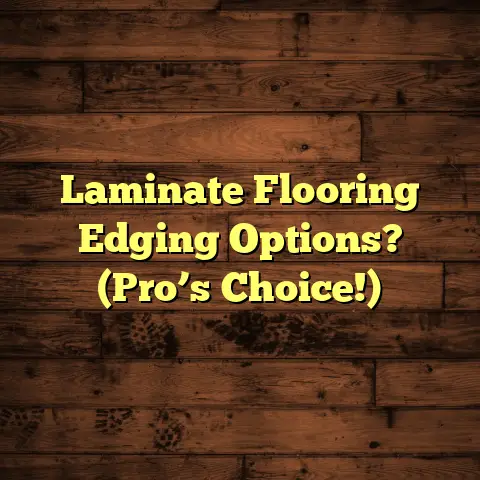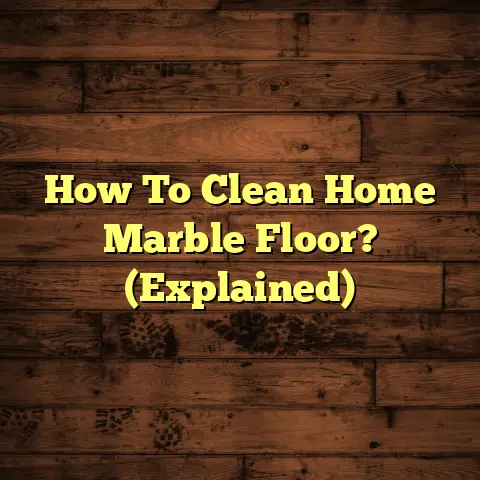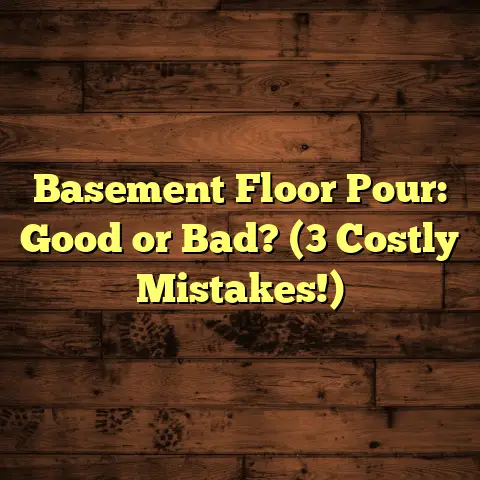Vinyl Flooring Adhesive: Which Type is Best? (1 Crucial Choice!)
(1 Crucial Choice!)
Imagine this: you walk into a living room bathed in sunlight.
The furniture? Soft and inviting. The vibe? Pure relaxation.
But what really ties it all together?
The floor. Smooth, seamless vinyl flooring.
Kids are playing, adults are chatting, and everyone’s comfortable.
That floor? It’s durable, easy to clean, and feels great underfoot.
But how does the adhesive you choose impact all of this?
That’s what we’re diving into today!
Understanding Vinyl Flooring
So, what exactly is vinyl flooring?
Well, it’s a synthetic flooring made primarily of polyvinyl chloride (PVC).
It’s a popular choice for many reasons, mainly because it’s affordable,
durable, and comes in a ton of styles. Think wood-look planks,
stone-look tiles, and even funky patterns.
There are a few main types you’ll run into:
-
Luxury Vinyl Tile (LVT): This is the fancy stuff.
It’s thicker, more realistic looking, and often comes in individual tiles.
-
Vinyl Sheet: This comes in large rolls and is great for covering
entire rooms quickly. It’s typically more budget-friendly than LVT.
-
Vinyl Plank: Similar to LVT, but in long planks mimicking hardwood.
Now, why is vinyl so popular?
-
Durability: It can handle high traffic and resist scratches.
-
Aesthetics: Seriously, the options are endless.
-
Easy Installation: Many types are DIY-friendly.
-
Water Resistance: Great for kitchens and bathrooms.
But here’s the kicker: to truly get the best results, you need to
choose the right adhesive. It’s not just an afterthought; it’s crucial!
The Role of Adhesive in Vinyl Flooring
Okay, let’s get down to the nitty-gritty.
What does flooring adhesive even do?
Simply put, it’s the glue that holds your vinyl flooring in place.
It creates a bond between the vinyl and the subfloor, preventing
movement, warping, and all sorts of other headaches.
Think of it as the foundation of your floor.
Without a solid foundation, things are bound to crumble.
Now, you might be wondering, “Do I always need adhesive?”
Not necessarily. Some vinyl flooring is designed for “floating”
installations. This means the planks or tiles click together and rest
on top of the subfloor without being glued down.
However, adhesive is essential in certain situations:
-
High-Traffic Areas: Where you need extra stability.
-
Moisture-Prone Areas: Where you need a waterproof bond.
-
Large Installations: Where you need to prevent movement.
-
Specific Vinyl Types: Some require adhesive for proper installation.
Types of Vinyl Flooring Adhesives
Alright, let’s talk about the different types of adhesives you’ll encounter.
Each has its own strengths and weaknesses, so it’s important to choose wisely.
Pressure-Sensitive Adhesives
These adhesives are designed to form a bond when pressure is applied.
Think of it like a super-sticky tape.
They’re often used with vinyl tiles and planks.
-
Advantages: Easy to apply, repositionable, and relatively clean.
-
Ideal Applications: Areas with low moisture and moderate traffic.
Good for DIYers because they’re forgiving.
When do they work well? I’ve used them in powder rooms and closets
with great success. They’re convenient and quick.
However, I wouldn’t recommend them for a busy kitchen or bathroom.
Full-Spread Adhesives
As the name suggests, these adhesives are applied evenly across the entire subfloor.
They create a strong, permanent bond.
-
Benefits: Superior adhesion, moisture resistance, and durability.
The go-to choice for demanding applications.
-
Use Cases: High-traffic areas, commercial spaces, and areas with
potential moisture issues.
They’re the workhorses of vinyl flooring adhesives.
I always recommend full-spread adhesives for kitchens, bathrooms,
and any area that gets a lot of foot traffic.
They provide the peace of mind that your floor won’t budge.
Glue-Down vs. Peel-and-Stick
Let’s break down two popular options: glue-down and peel-and-stick.
Glue-Down:
-
Installation: Requires applying adhesive to the subfloor and then
setting the vinyl in place.
-
Performance: Creates a strong, permanent bond that can withstand
heavy use and moisture.
-
Flexibility: Offers a wide range of adhesive options to suit
different needs.
Peel-and-Stick:
-
Installation: Simply peel off the backing and stick the vinyl to the subfloor.
-
Performance: Easier to install but may not be as durable or
moisture-resistant as glue-down.
-
Flexibility: Limited adhesive options; best for small areas with
low traffic.
Peel-and-stick is tempting because it’s so easy.
But, in my experience, it’s not a long-term solution for most areas.
Glue-down is more work upfront, but it pays off in the long run with
superior durability and performance.
The Crucial Choice
Okay, we’ve covered the basics. Now for the crucial choice:
What’s the most important factor to consider when choosing vinyl flooring adhesive?
In my opinion, it’s moisture resistance.
Why? Because moisture is the enemy of vinyl flooring.
If moisture gets underneath your flooring, it can lead to:
-
Adhesive Failure: The bond weakens, and the flooring starts to lift.
-
Mold and Mildew Growth: Unhealthy and can damage your subfloor.
-
Warping and Buckling: Unsightly and can create trip hazards.
Even if you’re not installing in a traditionally “wet” area like a bathroom,
moisture can still be a concern. Humidity, spills, and even cleaning
can introduce moisture to your floor.
That’s why I always recommend choosing an adhesive specifically
designed for moisture resistance, especially in kitchens, bathrooms,
and basements.
This one choice can make all the difference in the long-term durability,
ease of installation, and maintenance of your vinyl flooring.
Environmental Considerations
Let’s talk about being eco-conscious.
The good news is that there are plenty of eco-friendly adhesive options available.
Look for products that are:
-
Low-VOC (Volatile Organic Compounds): VOCs are chemicals that can
evaporate into the air and cause health problems.
Low-VOC adhesives minimize these emissions.
-
Water-Based: These adhesives use water as a solvent instead of
harsh chemicals.
-
Certified by Third-Party Organizations: Look for certifications
like GreenGuard or FloorScore, which indicate that the product has
been tested for emissions and performance.
The impact of VOCs is a real concern.
They can contribute to indoor air pollution and trigger allergies or asthma.
Choosing low-emission products is not only better for the environment
but also for your health.
I always recommend checking the product’s Safety Data Sheet (SDS)
to see its VOC content.
Installation Tips
Alright, let’s get practical. Here are some tips for a successful vinyl flooring installation:
-
Prepare the Subfloor: This is critical. The subfloor must be clean,
level, and dry. Remove any debris, fill any cracks or holes, and
ensure it’s completely dry.
-
Acclimate the Flooring: Allow the vinyl flooring to acclimate to the
room’s temperature and humidity for at least 48 hours before installation.
-
Apply the Adhesive: Follow the manufacturer’s instructions carefully.
Use the recommended trowel size and spread the adhesive evenly.
Don’t apply too much or too little.
-
Set the Flooring: Carefully place the vinyl tiles or planks into the
adhesive, pressing firmly to ensure good contact.
-
Roll the Floor: Use a floor roller to further ensure adhesion and
remove any air pockets.
Common pitfalls to avoid:
-
Skipping Subfloor Prep: This is the biggest mistake I see.
A poorly prepared subfloor will lead to problems down the road.
-
Using the Wrong Adhesive: Choosing the wrong adhesive can result in
adhesion failure and costly repairs.
-
Rushing the Installation: Take your time and follow the instructions carefully.
Rushing can lead to mistakes that are difficult to fix.
Maintenance and Longevity
So, you’ve installed your beautiful vinyl floor.
How do you keep it looking great for years to come?
The choice of adhesive plays a role in maintenance.
For example, if you used a moisture-resistant adhesive, you’ll have
more peace of mind when cleaning up spills.
Here are some general tips for maintaining vinyl flooring:
-
Regular Cleaning: Sweep or vacuum regularly to remove dirt and debris.
-
Damp Mopping: Use a damp mop and a mild detergent to clean the floor.
Avoid using harsh chemicals or abrasive cleaners.
-
Protect from Scratches: Use furniture pads under heavy objects to prevent scratches.
-
Clean Spills Immediately: Wipe up spills as soon as they happen to
prevent staining or damage.
I’ve seen firsthand how the right adhesive can extend the life of a vinyl floor.
I once worked on a project where the homeowner used a cheap, non-moisture-resistant adhesive.
Within a year, the flooring started to lift and buckle due to moisture damage.
They had to replace the entire floor, which was a costly and time-consuming project.
On the other hand, I’ve seen vinyl floors installed with high-quality,
moisture-resistant adhesives that have lasted for decades with minimal maintenance.
Conclusion
Choosing the right vinyl flooring adhesive is not a decision to take lightly.
It’s a critical factor that can impact the overall success of your flooring project.
While there are many options available, focusing on moisture resistance is key.
By making an informed choice, you can create a beautiful, durable,
and functional home environment that you’ll enjoy for years to come.
So, take your time, do your research, and choose wisely.
Your floors will thank you for it!





